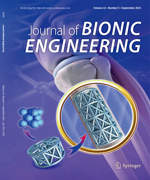|
|
Dragonfy Interaction Algorithm for Optimization of Queuing Delay
in Industrial Wireless Networks
Sanjay Bhardwaj, Da-Hye Kim & Dong-Seong Kim
Journal of Bionic Engineering. 2024, 21 (1):
447-485.
DOI: 10.1007/s42235-023-00462-7
In industrial wireless networks, data transmitted from source to destination are highly repetitive. This often leads to the
queuing of the data, and poor management of the queued data results in excessive delays, increased energy consumption,
and packet loss. Therefore, a nature-inspired-based Dragonfy Interaction Optimization Algorithm (DMOA) is proposed for
optimization of the queue delay in industrial wireless networks. The term “interaction” herein used is the characterization
of the “fying movement” of the dragonfy towards damselfies (female dragonfies) for mating. As a result, interaction is
represented as the fow of transmitted data packets, or trafc, from the source to the base station. This includes each and
every feature of dragonfy movement as well as awareness of the rival dragonfies, predators, and damselfies for the desired
optimization of the queue delay. These features are juxtaposed as noise and interference, which are further used in the
calculation of industrial wireless metrics: latency, error rate (reliability), throughput, energy efciency, and fairness for the
optimization of the queue delay. Statistical analysis, convergence analysis, the Wilcoxon test, the Friedman test, and the
classical as well as the 2014 IEEE Congress of Evolutionary Computation (CEC) on the benchmark functions are also used
for the evaluation of DMOA in terms of its robustness and efciency. The results demonstrate the robustness of the proposed
algorithm for both classical and benchmarking functions of the IEEE CEC 2014. Furthermore, the accuracy and efcacy
of DMOA were demonstrated by means of the convergence rate, Wilcoxon testing, and ANOVA. Moreover, fairness using
Jain’s index in queue delay optimization in terms of throughput and latency, along with computational complexity, is also
evaluated and compared with other algorithms. Simulation results show that DMOA exceeds other bio-inspired optimization
algorithms in terms of fairness in queue delay management and average packet loss. The proposed algorithm is also evaluated
for the conficting objectives at Pareto Front, and its analysis reveals that DMOA fnds a compromising solution between
the objectives, thereby optimizing queue delay. In addition, DMOA on the Pareto front delivers much greater performance
when it comes to optimizing the queuing delay for industry wireless networks.
Related Articles |
Metrics
|

 Table of Content
Table of Content
 Table of Content
Table of Content